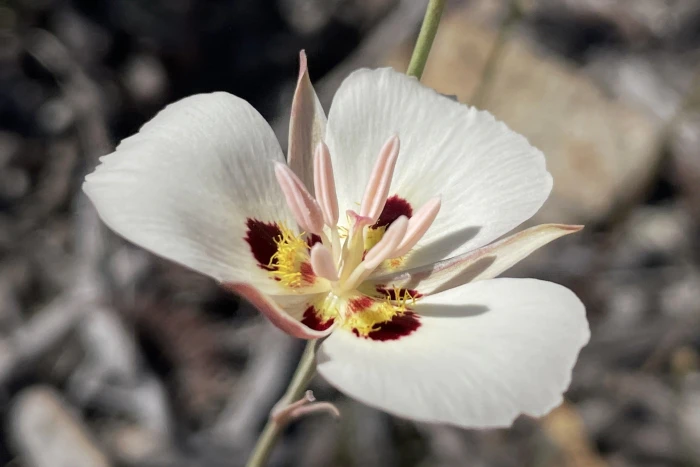Dunn’s Mariposa Lily
(Calochortus dunnii)
Dunn’s Mariposa Lily (Calochortus dunnii)
/
/

Madeleine Claire
CC BY 4.0
Image By:
Madeleine Claire
Recorded By:
Copyright:
CC BY 4.0
Copyright Notice:
Photo by: Madeleine Claire | License Type: CC BY 4.0 | License URL: http://creativecommons.org/licenses/by/4.0/ | Rights Holder: Madeleine Claire | Publisher: iNaturalist | Date Created: 2021-06-05T16:29:26Z |

























Estimated Native Range
Climate Requirements
| • Precipitation | 13" - 16" |
| • High Temp. | 85°F - 97°F |
| • Low Temp. | 32°F - 44°F |
Summary
Calochortus dunnii, commonly known as Dunn’s mariposa lily, is a perennial herb native to the chaparral, grasslands, and closed-cone pine forests of the Peninsular Ranges in southern San Diego County, California, and northern Baja California. It thrives at elevations between 185-1,830 feet (56-558 meters). This species typically features a slender, branching stem that can reach up to 24 inches in height and bears 2-6 erect, bell-shaped flowers. The flowers, blooming in late spring to early summer, are particularly showy with white or pinkish petals that are distinctively spotted with red and yellow, attracting pollinators such as bees and butterflies.
Dunn’s mariposa lily is valued for its ornamental flowers, which make it a desirable addition to native plant gardens and wildflower meadows. It requires well-drained soils and is drought-tolerant once established, making it suitable for xeriscaping. While it prefers full sun, it can tolerate light shade. Gardeners should be aware that over-collecting and habitat destruction are threats to this species, and it should not be removed from the wild. Cultivation should be from responsibly sourced seeds or nursery plants.CC BY-SA 4.0
Dunn’s mariposa lily is valued for its ornamental flowers, which make it a desirable addition to native plant gardens and wildflower meadows. It requires well-drained soils and is drought-tolerant once established, making it suitable for xeriscaping. While it prefers full sun, it can tolerate light shade. Gardeners should be aware that over-collecting and habitat destruction are threats to this species, and it should not be removed from the wild. Cultivation should be from responsibly sourced seeds or nursery plants.CC BY-SA 4.0
Plant Description
- Plant Type: Herb
- Height: 1-2 feet
- Width: 0.5-1 feet
- Growth Rate: Moderate
- Flower Color: White
- Flowering Season: Summer
- Leaf Retention: Deciduous
Growth Requirements
- Sun: Full Sun, Part Shade
- Water: Low
- Drainage: Medium, Fast
Common Uses
Bee Garden, Low Maintenance, Rock Garden
Natural Habitat
Native to chaparral, grasslands, and closed-cone pine forests within the Peninsular Ranges
Other Names
Common Names: Dunn’s Fairy Lantern
Scientific Names: Calochortus dunnii, Calochortus palmeri var. dunnii
GBIF Accepted Name: Calochortus dunnii